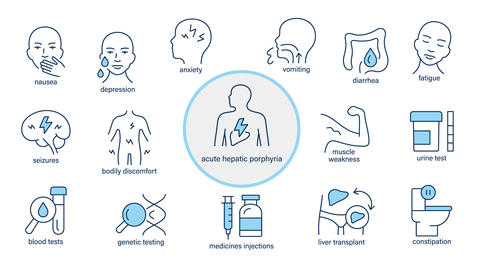A novel animal model for the development of therapies for acute intermittent porphyria (AIP)
Córdoba KM et al, Gut. 2025;74(2):270-283
This study demonstrated that knockdown of the gene encoding hepatic porphobilinogen deaminase (PBGD) in non-human primates can induce the clinical picture of AIP. In addition, administration of human PBGD mRNA subsequently corrected this phenotype. This model therefore appears suitable for further research into novel therapies for hepatic porphyrias.
Objective: Acute intermittent porphyria (AIP) is a rare metabolic disorder caused by haploinsufficiency of hepatic porphobilinogen deaminase (PBGD), the third enzyme of the heme biosynthesis. Individuals with AIP experience neurovisceral attacks closely associated with hepatic overproduction of potentially neurotoxic heme precursors.
Design: The authors replicated AIP in non-human primates (NHPs) through selective knockdown of the hepatic PBGD gene and evaluated the safety and therapeutic efficacy of human PBGD (hPBGD) mRNA rescue.

Results: Intrahepatic administration of a recombinant adeno-associated viral vector containing short hairpin RNA against endogenous PBGD mRNA resulted in sustained PBGD activity inhibition in liver tissue for up to 7 months postinjection. The administration of porphyrinogenic drugs to NHPs induced hepatic heme synthesis, elevated urinary porphyrin precursors and reproduced acute attack symptoms in patients with AIP, including pain, motor disturbances and increased brain GABAergic activity. The model also recapitulated functional anomalies associated with AIP, such as reduced brain perfusion and cerebral glucose uptake, disturbances in hepatic TCA cycle, one-carbon metabolism, drug biotransformation, lipidomic profile and abnormal mitochondrial respiratory chain activity. Additionally, repeated systemic administrations of hPBGD mRNA in this AIP NHP model restored hepatic PBGD levels and activity, providing successful protection against acute attacks, metabolic changes in the liver and CNS disturbances. This approach demonstrated better efficacy than the current standards of care for AIP.
Conclusion: This novel model significantly expands the understanding of acute intermittent porphyria (AIP) at the molecular, biochemical and clinical levels and confirms the safety and translatability of multiple systemic administration of hPBGD mRNA as a potential aetiological AIP treatment.